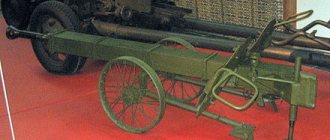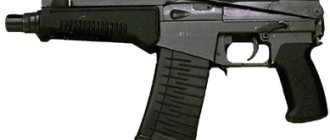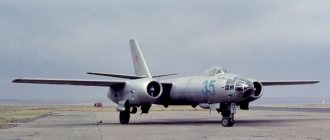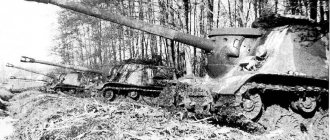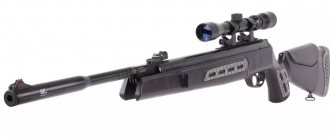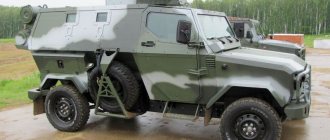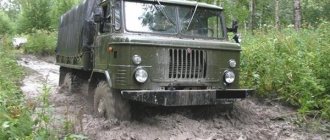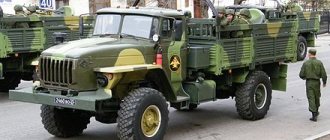Description of the design and principle of operation of the gun
The main feature of the MT 12, which distinguishes this gun from all previous models of Soviet anti-tank artillery, is its smooth barrel.
The long and thin-looking barrel makes the MT-12 look like a bladed weapon - a rapier
There are several main reasons why the Rapier designers abandoned traditional rifling:
- The rotation of the projectile upon impact with the target prevents the normal formation of a cumulative jet. As a result, the armor penetration characteristics deteriorate somewhat;
- When fired from a rifled gun, part of the energy of the powder gases is spent on spinning up the projectile, which reduces its ballistic characteristics;
- A smooth barrel wears out much less during intensive use. Friction is also significantly reduced, which has a positive effect on the projectile’s flight speed;
- The muzzle energy of smooth-bore weapons is always higher than that of rifled weapons;
- The gun is easier to adapt to launch anti-tank guided missiles. This advantage was not used immediately, but it is quite noticeable.
https://youtube.com/watch?v=QpX-KBSCkXc
Soviet designers, interestingly, were not “pioneers.” Already during the Second World War, Germany had smooth-bore artillery guns. Nevertheless, the Soviet military did not really believe in the proposed innovation, so in parallel with the creation of the T-12, several models of rifled anti-tank guns were being developed.
Looking at the MT-12 "Rapier" in the photo, it is easy to notice that its carriage is equipped with wheels that were once used on ZIL-150 trucks. Torsion bar suspension. Before firing, it is blocked, which guarantees stability and no swaying.
"Breech" of the MT-12 gun
There are also hydraulic brakes - before the development of the MT-12, they were not used on artillery chassis. Stability is ensured by spreading the beds. The gun, in addition, is equipped with an armor shield that protects the crew from bullets and shrapnel.
Refinement of shells
But with the adoption of different types of shots, the problems only began, since they all required serious modifications. In particular, sub-caliber shells were excellent at penetrating vertical layers of armor, but they were not nearly as convincing when dealing with inclined ones. The projectile either entered the armor at some incredible angle, or simply ricocheted. Dozens of decommissioned tanks were destroyed at testing grounds until experts found a solution that suited everyone.
Advantages and disadvantages
The MT-12 was the world's first smooth-bore anti-tank gun, and in the 60s of the last century it was the best example of such weapons.
Shooting from MT-12. A huge flash of fire unmasks the weapon
Its advantages include:
- The Rapier gun has armor penetration characteristics sufficient to destroy tanks of the 60-70s of the last century. The gun confidently hits targets such as the M60, Chieftain or T-54/55, not to mention light armored vehicles;
- High shooting accuracy. This gun was sometimes even called an “artillery sniper rifle.” The gunner can fire not just “at the silhouette”, but at the most vulnerable spots of the tank;
- Versatility. The gun can fire not only direct fire, but also from closed positions, using high-explosive fragmentation shells. In addition, the Rapier is successfully used to destroy fortified firing points;
- All-weather. Later modifications allow you to confidently fight in smoke and fog conditions;
- The low silhouette of the gun makes it a rather difficult target for enemy artillery.
The MT-12 also has many disadvantages:
- The gun is not capable of penetrating the combined frontal armor of modern tanks. In addition, the shells of this gun are unlikely to be able to overcome the onboard dynamic protection;
- The crew on the battlefield does not have full protection and is easily vulnerable;
- The mobility of the gun depends entirely on the tractor;
- Even with the most careful camouflage, a weapon can be seen from a drone. In battle, the cannon will be given away by its very first shot - the fiery flash is clearly visible even at very long distances;
- In terms of firing range and maneuverability, the MT-12 is significantly inferior to modern anti-tank missile systems.
One of the MT-12 guns used during the armed conflict in eastern Ukraine
In general, today the disadvantages clearly outweigh the advantages - the gun is seriously outdated and its continued use in regional conflicts is explained mainly by the lack of more modern weapons systems among the warring parties.
Design
OSCE observer photo of MT-12 Ukrainian troops.
February 2020. Structurally, the gun is a smooth-bore anti-tank gun on a classic two-frame carriage.
Gun barrel
The gun barrel consists of a 100-mm smooth-walled monoblock tube with a muzzle brake, breech and clip.
Carriage
Sights
The following artillery sights are installed on the MT-12:
- For direct fire in the daytime (at a visible target) - an OP4MU-40U optical sight [2], which is removed from the gun only before long and difficult marches or during long-term storage;
- For firing from closed positions (at an invisible target) - mechanical sight S71-40 with a PG-1M panorama and a K-1 collimator;
- For night shooting - 1PN35, night sight APN-6-40 "Brusnika"; or 1PN53, night sight APN-7[3];
The PG-1M panorama is an optical device that is necessary for accurately aiming a gun at a target in horizontal and vertical planes[4].
The K-1 collimator is an optical device designed for horizontal aiming of a gun in the absence of natural aiming points or in conditions of poor visibility (in fog, snowfall, smoke in the firing position).
The Luch-S71M lighting device is also used to illuminate the gun sights at night.
Transportation
Since the MT-12 uses wheels from a ZIS-150 truck with a “GK” tire (sponge rubber [5] - size 9.0-20, model Y-37), transportation was carried out by towing with an MT-L (MT) crawler tractor -LB), tractor-trailers Ural-375D and Ural-4320. When driving on snow, the LO-12 ski rig was used.
History of the development of the MT-12 "Rapier" anti-tank gun
In the 50s of the last century, the Soviet army still had guns developed during the Second World War. They coped with their main tasks quite well, but there were certain reasons to believe that heavy tanks would soon appear in the NATO countries, the armor of which would become invulnerable to such guns as the BS-3 and D-10T, which once confidently fought with the Panthers. and the Tigers.
BS-3 is a 1944 model anti-tank gun. Remained in service with the Soviet army until the 60s of the last century
Thus, the need arose to create a new gun with significantly improved characteristics. Of course, it was possible to increase the caliber, however, this method, which was repeatedly used during the war years, would inevitably lead to the appearance of a bulky and clumsy weapon, which contradicted the very concept of anti-tank artillery. A 100 mm caliber gun can maintain high maneuverability, but when switching to 152 mm, this will no longer be possible. Therefore, the designers of the Yurginsky Machine-Building Plant took a different path: they decided to abandon traditional rifling in the barrel. At that time, this was perhaps the most promising innovation.
Taking the serial D-48 gun as a basis, the designers “bored” its rifled 85-mm barrel to 100 mm caliber, leaving the walls smooth and adding a muzzle brake to the gun. At the same time, no changes were initially made to the two-frame carriage. After extensive testing, the gun was adopted by the Soviet Army under the designation T-12. This happened in 1961.
A few years later, the troops received the now widely known MTLB - a lightly armored multi-purpose tractor (transporter). This vehicle was perfect for towing an anti-tank gun over rough terrain, but the speed was too high - the outdated T-12 carriage could not withstand it, so it had to be replaced.
MT-12 with crew and MT-LB tractor
Since 1980, the Rapier anti-tank gun has been able to fire Kastet guided missiles, launched directly through the barrel. Almost simultaneously, a new modification of the gun appeared, equipped with a radar sight, which made it possible to hit targets at night and in poor visibility conditions.
Despite the fact that in subsequent years the Rapier's obsolescence as an anti-tank weapon became increasingly obvious, it remains in service to this day. The gun is still capable of fighting light armored vehicles, in addition, it can be used as a conventional field weapon, including for indirect fire.
This is interesting: 683, Japanese detachment 731 - we explain point by point
Modifications:
T-12/2A19
— 100 mm anti-tank gun, basic version of the mid-1950s.
MT-12/2A29 "Rapier"
— 100-mm anti-tank gun, a modernized version of the 1971 model.
MT-12R / 2A29R "Rapier"
— 100-mm anti-tank gun with an aiming system with 1A31 “Ruta” radar. The modification was put into service in 1981.
The 100-mm anti-tank gun was developed at the design bureau of the Yurga Machine-Building Plant No. 75 under the leadership of V.Ya. Afanasyev and L.V. Korneev. The first version of the T-12 entered service in the mid-1950s. After changes were made to the carriage design in 1971, a modernized version of the MT-12 (2A29) called “Rapier” was adopted. In the 1990s, a modification of the MT-12R (2A29R) with the 1A31 Ruta radar was adopted.
The artillery unit of all modifications is the same, the guns differ only in the carriage. The smooth barrel, 61 caliber long, is made in the form of a monoblock pipe assembled with a muzzle brake, breech and clip. The carriage is equipped with sliding frames. Modifications MT-12/MT-12R are distinguished by a torsion bar suspension of the carriage, which is locked when firing. The lifting mechanism is sector type, the rotary mechanism is screw type. Both mechanisms are located to the left of the barrel, with a pull-type spring balancing mechanism located on the right. The wheels are used from a ZIL-150 car with GK tires. When rolling the gun manually, a roller is placed under the frame, which in the firing position rises up and is secured with a stopper on the left frame. For movement on snow, the LO-7 ski mount is used, which allows firing from skis at elevation angles of up to +16° with a rotation angle of up to 54°, and at an elevation angle of 20° with a rotation angle of up to 40°.
For direct fire, the T-12 modification is equipped with an OP4M-40 day sight and an APN-5-40 night sight. The MT-12/MT-12R modifications are equipped with an OP4M-40U day sight and an APN-6-40 night sight. For indirect shooting there is a S71-40 sight with a PG-1M panorama.
Unitary type ammunition
. A ZUBM-10 shot with a ZBM24 armor-piercing sub-caliber projectile with a swept warhead. Weight – 19.9 kg. Length - 1140 mm. Armor penetration - 215 mm at a distance of 1000 m. ZUBK-8 round with a ZBK16M cumulative projectile. A distinctive feature of the projectile is that it is equipped by pressing into the body. Weight – 23.1 kg. Length - 1284 mm. ZUOF-12 shot with a ZOF35K high-explosive fragmentation projectile. A distinctive feature of the projectile is that it is equipped with batch pressing into the body. Weight – 28.9. Length - 1284 mm. ZUBK-10-1 shot with a 9M117 missile (ATGM 9K116 “Kastet”). To reduce dimensions, the solid fuel jet engine is made with two oblique nozzles located at the front. The body is made according to the canard aerodynamic design with front placement of aerodynamic control surfaces and an air-dynamic steering drive, made in a closed design with a frontal air intake. The deployable rear wings are placed at an angle to the longitudinal axis of the rocket and ensure its rotation in flight. The main units of the onboard guidance system equipment with a laser radiation receiver are located in the tail section. The anti-tank complex is equipped with semi-automatic laser beam guidance. The complex includes Volna control equipment, including a 1K13-1 sight-guidance device with an 8-fold magnification of the day channel and 5.5-fold magnification of the night channel, and a 9S831 voltage converter. The length of the rocket is 1048 mm, the span of the stabilizers is 255 mm, the weight is 17.6 kg. Armor penetration - 550-600 mm of armor with dynamic protection. Firing range - 100-4000 m. Initial speed - 400-500 m/s. Marching speed - 370 m/s. Flight time at maximum range is 13 seconds.
Tactical and technical characteristics of the T-12 - MT-12/MT-12R Crew - 6-7 people Length of the gun in the stowed position - 9500 mm - 9650 mm Barrel length - 6126 mm Width of the gun in the stowed position 1800 mm - 2310 mm Track width - 1479 mm - 1920 mm Vertical pointing angles - from -6 to +20 degrees Horizontal pointing angles - 54 degree sector Weight in firing position - 2750 kg - 3100 kg Projectile weight - 5.65 kg (sub-caliber) - 4.55 kg (BPS ZBM24) - 4.69 kg (cumulative) - 9.5 kg (KS ZBK16M) - 16.7 kg (OFS ZOF35K) Projectile initial speed - 1575 m/s (sub-caliber) - 1548 m/s (BPS ZBM24) - 975 m/s ( cumulative) - 1075 m/s (KS ZBK16M) - 905 m/s (OFS) Shot range - maximum 8200 m - 3000 m (BPS) - 5955 m (KS) - 8200 m (OFS) Sighting range - 1880-2130 m (BPS) - 1020-1150 m (KS) Rate of fire - 6-14 rds/min. Carryable ammunition - 20 rounds, incl. 10 BPS, 6 KS and 4 OFS Transportation speed on the highway - 60 km/h
Once appearing on the battlefield, the tank became the infantryman's nightmare for a long time. The first of these vehicles were practically invulnerable, and they were fought only by digging anti-tank ditches and creating defensive ditches.
Then came the power of which, by today’s standards, is simply ridiculous. Even at that time, tanks, having increased their armor again, could no longer fear most of these weapons. And then anti-tank guns came onto the scene. They were imperfect and clumsy, but the tankers immediately began to respect them.
Applications and disadvantages
Not a single type of weapon is without its drawbacks. The tool is characterized by a high degree of versatility of use. This is facilitated by the high initial velocity of the projectile (more than one and a half kilometers per second), the large mass of ammunition, a possible elevation angle of 20 degrees, rate of fire (a shot every 10 seconds) and many other advantages. Currently, a dozen and a half countries are armed with MT-12 Rapier guns. A photo of the characteristic silhouette of a gun accompanies reports from conflict zones, both remote from Russian borders and very close. However, some operators have already abandoned its use. The reason for this was both physical wear and tear without the possibility of full restoration, and a design flaw in a muzzle brake that was very successful in many respects. The fact is that when fired, it significantly compensates for recoil, but at the same time unmasks the position with a bright flash of hot powder gases escaping from the holes at the end of the barrel. The Russian Army is armed with more than two and a half thousand MT-12 Rapier guns, most of which have been mothballed.
Further development of the project
Very soon, Soviet tank crews also noticed the new gun. They were impressed by the power and low recoil of the smoothbore gun and its light weight. The first samples were hastily collected, which immediately made an indelible impression on the military.
Being installed on the chassis of the T-54 tank, the new 100-mm Rapier cannon pierced training targets (decommissioned hulls of the same T-54) right through, and from extreme distances. There was practically nothing left of the sheep that played the role of the crew.
In 1960, the Rapier gun, modified to the required state, began to be mounted on an experimental chassis (based on the T-55 tank). Soon after this, all tests of the D54 were completely completed, as the new smoothbore gun showed its absolute superiority. The difference from the “infantry” modification is that the tank gun of this series does not have a muzzle brake. Just six months later, the Rapier tank gun (a photo of which can be seen in this material) was put into service under the designation 2A20 Stiletto.
The fact is that with a caliber of 100 mm it was not particularly needed. Taking into account the fact that Soviet tanks were never distinguished by their prohibitive dimensions and weight, and the muzzle brake greatly increases recoil, its installation in the domestic tank industry was practiced only in cases where all other extinguishing methods had already been tried and did not give the desired result.
Mobility and maneuver
The designers tried to solve the problems of quickly delivering anti-tank artillery weapons to a section of the front that was under threat of a breakthrough in various ways, including installing a motorcycle engine on the carriage.
The 100-mm T-12 anti-tank gun, created by the Yurginsky Machinery Plant design bureau under the leadership of L.V. Korneev and V.Ya. Afanasyev, is mounted on a single-axle bogie with wheels from the ZIL-150, the carriage has a torsion bar suspension with an increased spring suspension travel. The simplified design did not require hydraulics; the MT-12 “Rapier” gun in the transport position turned out to be resistant to vibration and shaking.
The gun is accompanied by an MT-L tractor or an armored MT-LB, inside which a crew consisting of at least four (maximum six) people is located relatively safely. Towing can be done at speeds of up to 60 km/h with a range of 500 km. On the march, the guidance mechanisms are wrapped in a tarpaulin cover to avoid contamination.
At the firing position
One of the main requirements for anti-tank weapons - maneuverability - was met. The weight of the gun is approximately three tons, which is well within the standards for suitability for airmobile delivery. The silhouette turned out to be squat, which makes it difficult for the enemy to visually detect the firing point.
The MT-12 “Rapier” barrel (long, 61 caliber), together with the breech, clip and muzzle brake, forms a single unit. The simplicity of the design guarantees a quick transfer to the combat position after uncoupling from the tractor; to do this, it is enough to open the frame, lower the lower flap of the armored shield and install a sight. The shells are fed manually and are heavy (about 80 kg). Before opening fire, the bolt is opened manually, then, after ejecting the first cartridge, this operation takes place automatically.
The descent is carried out either by pressing the handle or by means of a cable attached to it.
Features of other types of shots
Cumulative and standard high-explosive fragmentation rounds had a similar design. In their case, the projectile body was also rigidly connected to the tail bushing on which the tail was attached. The difference was the absence of an obturating belt and the diameter, which coincided with that of the trunk. For cumulative projectiles, a bushing with five fin blades was used, and in the case of a high-explosive fragmentation shot, with six.
Cumulative and high-explosive fragmentation shots did not place such high demands on the cartridge case, and therefore it was made from ordinary (varnish-clad) steel. Projectiles of the sub-caliber type were loaded exclusively into a high-quality brass case, which did not wear out the weapon as much. “Rapier” was a very expensive gun at that time, and therefore experts were looking for any ways to increase its service life.
Competition of guns and ATGMs
By the end of the sixth decade, the ground forces of industrialized countries had at their disposal a new anti-tank weapon - ATGMs. In essence, guided missiles were missiles with controls in the form of rotary wings. Their guidance is carried out either via a radio channel, or (to avoid interference) via a long thin cable that unwinds from a reel and trails behind. It seemed that now the artillery had once again lost ground before the inexorably approaching scientific and technological progress. However, military budgets are also not bottomless, and ATGMs are not a cheap thing. Then military experts again turned to the good old guns and, to their displeasure, discovered an obvious contradiction. The required accuracy was ensured by rifled barrels, but, alas, they had limitations in caliber. And suddenly, unexpectedly, this problem was solved as a result of the revolutionary approach of the creators of the MT-12 Rapier gun.
Anti-tank gun MT-12 Rapier - video
https://youtube.com/watch?v=dRs18gLFwso
The T-12 and MT-12 guns have the same warhead - a long thin barrel 60 calibers long with a salt shaker muzzle brake.” The sliding beds are equipped with an additional retractable wheel installed at the openers. The main difference of the modernized MT-12 model is that it is equipped with a torsion bar suspension, which is locked when firing to ensure stability.
Although the T-12/MT-12 gun is designed primarily for direct fire, it is equipped with an additional panoramic sight and can be used as a regular field gun for firing high-explosive ammunition from indirect positions.
To combat armored targets, an armor-piercing sub-caliber projectile is used with a swept warhead, which has high kinetic energy and is capable of penetrating 215 mm thick armor at a distance of 1000 meters. Such ammunition is usually associated with tank guns, but the T-12 and MT-12 use single-loading shells that are different from the ammunition of the 100 mm D-10 tank gun installed on the T-54 and T-55 family of tanks. Also, the T-12/MT-12 cannon can fire cumulative anti-tank shells and 9M117 “Kastet” ATGMs, guided by a laser beam.
One of the modifications of the T-12 was produced in the former Yugoslavia: a 100 mm barrel was installed on the carriage of a 122 mm D-30 howitzer. This modification was designated "TOPAZ".
Modifications
MT-12K (2A29K) - In 1981, the 9K116 “Kastet” anti-tank missile system (Tula KBP headed by A.G. Shipunov), designed to destroy armored vehicles, as well as small targets, was adopted by the USSR ground forces. The “Kastet” complex consists of a ZUBK10 shot with a 9M117 guided missile and 9Sh135 aiming and guidance equipment. The control system is semi-automatic using a laser beam. AK "Tulamashzavod" has mastered serial production of the modernized 9M117M "Kan" ATGM missile as part of the 3UBK10M round with a tandem cumulative warhead capable of penetrating the armor of tanks equipped with dynamic protection.
MT-12R (2A29R) - The MT-12R, “Ruta” complex was adopted for service and put into serial production in 1981. The all-weather radar sighting system 1A31, code "Ruta", installed on the MT-12 anti-tank gun, was created in 1980 at the Design Bureau of the Strela Research Institute (Chief Designer V. I. Simachev). The production of the 1A31 sight was carried out in 1981-1990.
M87 TOPAZ - Yugoslav modification of the MT-12. The main feature is the use of a carriage from the D-30 howitzer. The OMS also includes a laser rangefinder with a range from 200 to 9995 meters.
Sights
The kit includes a standard panoramic optical sight OP4M-40U. An anti-reflective filter is used to fire against the sun. APN-6-40 night vision can be used as additional guidance means, and when firing in extremely difficult meteorological conditions (fog, heavy snow, rain) and in the absence of direct visibility, a radar device is installed on a special bracket. In addition, it is possible to adjust fire against hidden targets, according to information received from external sources. The Rapier anti-tank gun can also fire missiles (after installing special laser beam guidance equipment on it).
Photo MT-12 Rapier
Unlike, for example, aircraft, they rarely assign names, content with an alphanumeric index. The exception is a few samples, among which is the MT-12 anti-tank gun. “Rapier” - that’s how the troops respectfully call it. It really is somewhat reminiscent of this piercing edged weapon. A long barrel, an elegant protective shield cover reminiscent of a guard (small, but very rational), “touché” accuracy - all these qualities would have been quite to the liking of duelists of past centuries. Today's artillerymen are preparing for a different kind of fight. The gun, despite its decades of age, is still in service. It's not outdated.
Notes
- Shirokorad A. B. Smooth-bore anti-tank guns (“Octopus” and “Rapier”) // Equipment and weapons yesterday, today, tomorrow...: Journal. - Moscow: ROO "Techinform", 1997. - No. 10
- Shirokorad A. B.
Encyclopedia of domestic artillery. - Minsk: Harvest, 2000. - P. 631-632. — 1156 p. — ISBN 985-433-703-0. - (unavailable link). Retrieved April 11, 2014.
- International Institute for Strategic Studies.
The Military Balance 2020 / James Hackett. - London: Taylor&Francis, 2020. - P. 82. - 504 p. — ISBN ISBN 9781857438352. - The Military Balance 2020. - P. 205.
- International Institute for Strategic Studies.
The Military Balance 2020 / James Hackett. - London: Taylor&Francis, 2020. - P. 185. - 504 p. — ISBN ISBN 9781857438352. - International Institute for Strategic Studies.
The Military Balance 2020 / James Hackett. - London: Taylor&Francis, 2020. - P. 187. - 504 p. — ISBN ISBN 9781857438352. - International Institute for Strategic Studies.
The Military Balance 2020 / James Hackett. - London: Taylor&Francis, 2020. - P. 188. - 504 p. — ISBN ISBN 9781857438352. - International Institute for Strategic Studies.
The Military Balance 2020 / James Hackett. - London: Taylor&Francis, 2020. - P. 275. - 504 p. — ISBN ISBN 9781857438352. - International Institute for Strategic Studies.
The Military Balance 2020 / James Hackett. - London: Taylor&Francis, 2020. - P. 190. - 504 p. — ISBN ISBN 9781857438352. - International Institute for Strategic Studies.
The Military Balance 2020 / James Hackett. - London: Taylor&Francis, 2020. - P. 203. - 504 p. — ISBN ISBN 9781857438352. - International Institute for Strategic Studies.
The Military Balance 2020 / James Hackett. - London: Taylor&Francis, 2020. - P. 208. - 504 p. — ISBN ISBN 9781857438352. - International Institute for Strategic Studies.
The Military Balance 2020 / James Hackett. - London: Taylor&Francis, 2020. - P. 205. - 504 p. — ISBN ISBN 9781857438352. - The Military Balance 2010. - P. 245.
- The Military Balance 2013. - P. 117.
- The Military Balance 2010. - P. 124.
- The Military Balance 2010. - P. 189.
- (unavailable link). Retrieved December 9, 2012.
Ammunition
In towed position.
The gun's ammunition includes several types of sub-caliber, cumulative and high-explosive fragmentation shells, as well as Kastet guided anti-tank missiles. Carryable ammunition: 20 rounds, of which 50% are BPS, 20% are OFS, 30% are KS..
Armor-piercing sabot shells (APS)
- 100-mm UBM1 and UBM2 rounds with armor-piercing sub-caliber shells ZBM1 (with a core) and ZBM2 (without a core) are designed for firing at tanks, self-propelled guns and other armored targets.
- The 100-mm armor-piercing sub-caliber round UBM10 with a core, with the armor-piercing sub-caliber projectile ZBM24 with a swept warhead, is designed to destroy armored vehicles.
- Armor-piercing sub-caliber round UBM15, R&D “Valshchik”.
High-explosive fragmentation shells (HEF)
- The 100-mm UOF3 round with the 3OF15 high-explosive fragmentation projectile, equipped with a B-429E fuse, is intended for firing at manpower, firing points, field engineering structures and other targets. The initial projectile speed is 667 m/s.
- 100-mm high-explosive high-explosive fragmentation round UOF12 with a high-explosive fragmentation projectile 3OF35, designed to destroy enemy personnel, field fortifications, field-type engineering structures, artillery firing positions, mortars, rocket launchers, infantry fire weapons. Initial projectile speed 663 m /With.
Cumulative projectiles (CS)
- 100-mm UBK2 and UBK2M rounds with cumulative fragmentation shells ZBK3 and ZBK3M, equipped with a GPV-2 fuse, are designed for direct fire at armored targets with powerful armor protection, at light shelters and manpower. NII-24.
- 100-mm cumulative increased armor penetration rounds UBK8 and UBK8M with cumulative projectiles 3BK16 and 3BK16M are designed to destroy armored targets, as well as manpower, fortifications and engineering structures, artillery firing positions, mortars, and rocket launchers.
3UBK10 and 3UBK10-1 rounds with a 9M117 guided missile.
Inert (blank: training and practical) projectiles
- High-explosive high-explosive fragmentation inert shot UOF12 IN;
- Cumulative inert shot UBK8 IN;
- 3UP4 shot with a practical 3P7 cumulative projectile (analogous to the 3BK3M projectile);
- Shot with a practical cumulative projectile 3P27 (analogous to the 3BK16M projectile);
- Blank shot 4X20
- Blank shot X20N;
- Blank shot X20P;
- Charge for hydroshooting.
Characteristics of ammunition
For an anti-tank gun, ammunition is the first priority. Even a phenomenally long-range and reliable weapon turns into a “pumpkin” if outdated, low-quality shells are used for it. And the Rapier cannon, the performance characteristics of which are given above, is the best confirmation of this.
Ammunition for the new weapons also caused a lot of trouble, as they had to be developed anew. The main type is sub-caliber and cumulative. To destroy enemy personnel, a standard high-explosive fragmentation shot is used. Crew training is carried out using training sub-caliber projectiles. The plumage of the latter caused a lot of problems, since there was simply no experience in creating something like that, and the smooth-bore 100-mm gun itself had not yet been properly mastered by the domestic industry.
The difficulty was that the projectile with non-opening blades had to fit quite reliably to the barrel channel without forming backlash. Dozens of concepts were accepted and immediately discarded, but none satisfied all the requirements of the designers. Oddly enough, the solution that was proposed at the very beginning and rejected “due to its primitiveness” turned out to work. This once again confirmed that the simplest is often the most reliable.
Design of the T-12 / MT-12 "Rapier" gun
A characteristic feature of the MT-12 “Rapier” is a long and thin monoblock barrel with a muzzle brake, breech and clip. The barrel is the same for all modifications of the gun, but with the carriage the story is completely different. Initially, for the T-12, the carriage was taken from the 85-mm anti-tank D-48. A carriage with sliding frames, a retractable wheel on one of the frames - all this remains from it.
But 100 mm is not 85 mm; the borrowing turned out to be too “flimsy”. Then the “rapier” itself appeared - for which the carriage had to be developed from scratch. The modernized MT-12 model featured a torsion bar suspension for the carriage, which was locked when firing. The lifting mechanism of the weapon is of a sector type, and the rotary mechanism is of a screw type. Both mechanisms are located on the left, and on the right there is a pull-type spring balancing mechanism.
Transportation of T-12 and MT-12 guns (their own wheels are from the ZIS-150 truck) is carried out by a standard MT-L (MT-LB) tractor or Ural-375D and Ural-4320 tractor vehicles. When driving on snow, the LO-12 ski rig was used. When rolling the gun manually, a roller is placed under the trunk part of the frame, which is secured with a stopper on the left frame.
T-12 anti-tank gun
ps
Please note that with the “tank rapier” it turned out to be an interesting leapfrog with calibers. Initially, they decided to “fit” the tank version of the “Rapier” into the new T-62 tank
But due to the difference in the length of the unitary shot, the gun in its original form was not suitable for the T-62. Since the advantages of a smooth-bore gun were already obvious, it was decided to make a smooth-bore one from the rifled D-54 intended for the tank. They did the job perfectly, and the caliber of the original 100-mm D-54 rifled gun, after cutting off the rifling, “grew” to a 115-mm smoothbore gun, which was now called the U-5TS. The “tank” index of the 2A20 gun was not changed, hence all the subsequent confusion.
• Artillery Directory • Artillery of the same period •
What was used to create it?
To speed up the work, we took the carriage from the D-48 cannon, slightly changing its design. But field tests immediately showed that it was too flimsy for a new weapon. I had to redo this part literally from scratch. The gun passed new tests with honor and was put into service. It is known as the 105 mm T-12 gun. The modern “rapier” differs greatly from it.
The barrel of the new gun was made according to a monoblock design. Length – 6510 mm. The designers preferred to use an active-reactive version of the muzzle brake. The breech is equipped with a vertical wedge gate. Shooting was carried out directly from the wheels; no additional fixation (by locking the suspension) was required.
To give you a better idea of what the Rapier cannon, the characteristics of which we have briefly described, is capable of, we suggest taking a look at the table.
Characteristics of the T-12 2A19 gun
| Caliber | 105 mm |
| Number of service personnel (implement crew) | Six persons |
| Weight | 3280 kg |
| Overall length of the gun | 9980 mm |
| Projectile mass (depending on characteristics), kg | 5,21/11,4/19,5 |
| Firing range, maximum | 8700 m |
Note that this is not a modern Rapier cannon. The characteristics of its latest modifications are much more serious.
Suitable ammunition for weapons
The Rapier artillery gun is capable of firing various types of ammunition. All of them are made in the form of a unitary shot (a projectile along with a cartridge case and a powder charge).
The following options are used:
- Cumulative shots. These are UBK8 and UBK8M, with which you can destroy protected firing positions, engineering structures, as well as enemy tanks and armored vehicles;
- Cumulative fragmentation shots. These are UBK2 and UBK2M, which can be used both against armored vehicles and enemy infantry;
- Sub-caliber shots. All their varieties are designed exclusively to destroy armored vehicles. The MT-12 can fire UBM15 and UBM10 (these projectiles are equipped with a special warhead made in the shape of a tungsten arrow), as well as UBM1 and UBM2 (the projectile of this shot does not have a core);
- High-explosive fragmentation rounds are represented by the UOF3 and UOF12 models. The second option features a warhead with increased power. Both types of ammunition are intended for firing at enemy personnel and his field fortifications;
- Guided missile "Kastet" (9M117). Launched through a cannon barrel. The cumulative warhead ensures penetration of homogeneous armor 800 mm thick. Firing range is up to 5.5 km.
Guided missiles "Kastet" that can be fired by the MT-12
Shells
Depending on the nature of the target, three main types of ammunition are used. Sub-caliber samples are used to combat tanks. If the target has an increased level of protection, it makes sense to fire with cumulative fragmentation ammunition, which is characterized by the greatest armor-piercing power. High-explosive fragmentation shells are designed to combat manpower and suppress engineering firing points. For artillery ammunition, the effective direct fire range is 1880 meters. The maximum projectile range is over 8 km.
Guided missiles, which can also be fired by MT-12 Rapier anti-tank guns, accurately hit targets four kilometers away.
In service
Serbian "Rapier".
Cumulative shot to the cannon.
- Azerbaijan Azerbaijan - 72 MT-12, as of 2017
- Armenia Armenia - 36 MT-12, as of 2020
- Bulgaria Bulgaria - 126 MT-12, as of 2020
- Georgia Georgia - 40 MT-12, as of 2020
- Kazakhstan Kazakhstan - 68 T-12/MT-12, as of 2016
- Kyrgyzstan Kyrgyzstan - 18 T-12/MT-12, as of 2016
- Moldova Moldova - 37 MT-12, as of 2020
- Mongolia Mongolia - some, as of 2016
- Russia Russia - 526 MT-12, (2000 T-12/MT-12 in storage), as of January 2020
- Turkmenistan Turkmenistan - 60 T-12/MT-12, as of 2016
- Uzbekistan Uzbekistan - 36 T-12/MT-12, as of 2016
- Ukraine Ukraine - at least 500 T-12/MT-12, as of 2016
Former operators
- Algeria Algeria - 10 T-12, as of 2010
- Bosnia and Herzegovina Bosnia and Herzegovina - 155 T-12/MT-12, as of 2013
- Hungary Hungary
- GDR GDR
- Iraq Iraq
- Poland Poland
- USSR USSR
- Yugoslavia Yugoslavia
- Croatia Croatia - 133 T-12, as of 2010
- Montenegro Montenegro - 36 MT-12, as of 2010
Where can you see
- Russia - Museum of Russian Military History in the village of Padikovo, Istrinsky district, Moscow region.
- Russia, Trans-Baikal region, town. Chernyshevsk - near the monument to WWII participants.
- Russia, Vologda region, Vologda - Victory Park
- Russia, Bashkortostan, Sterlitamak, Victory Park
- Russia, Saratov region, Saratov, Victory Park on Sokolovaya Hill.
- Russia, Penza region, r.p. Zemetchino
- Russia, Republic of Bashkortostan, Stella of Victory
- Russia, Ivanovo region, village of Novo-Talitsy, Tsvetaeva street - near the monument to WWII participants.
- Russia, Penza region, Nikolsk, Teatralnaya street.
- Belarus, Nesvizh
Artillery tractor YA-12. Dimensions. Weight. Load capacity. Engine
The need for new powerful and high-speed tractors in the Red Army appeared in the fall of 1941, when modern medium and heavy tanks, as well as artillery pieces, began to arrive at the front in significant quantities. The production of the previous tractors (with the exception of the light STZ-5) was discontinued, and the remaining vehicles of this type in service were already quite worn out and, moreover, did not meet the requirements of the time.
The project of a new artillery tractor with the designation “D” was developed at the beginning of 1942 by NATI department engineer E.G. Popov. An interesting feature of its design was the parallel arrangement of two GAZ-MM power plants, which transmitted power to a transverse shaft located behind. The chassis was mostly borrowed from the T-60 light tank. A prototype of the vehicle, built by the NATI experimental design plant, was tested in the fall of 1942 and then, in order to be finalized and prepared for serial production, was transferred to the Yaroslavl Automobile Plant (YAZ).
YaAZ specialists, in collaboration with NATI engineers, slightly changed the layout of the art tractor, improved its suspension and increased the total weight, which led to a decrease in the maximum speed of the vehicle, but increased its traction force to 5200 kgf! In this form, the high-speed tractor received the designation Y-11 and was adopted by the Red Army in April 1943. The initial order for it was 50 copies, but serial production was disrupted by a German air raid on the GAZ engine plant. The current critical situation was overcome only thanks to an unexpected shipment of power units arriving from the USA, which included a GMC-4-71 diesel engine, a disc clutch and a five-speed gearbox. Within a month, these units and newly developed fuel and other systems were equipped with an artillery tractor, which received the next index Y-12. It was presented to the commission in Moscow, and after the approval of the Soviet leadership, serial production of this machine began. In total, from August to the end of 1943, 285 Ya-12 tractors were manufactured.
Ya-12 tractors were used primarily in artillery formations and demonstrated good reliability and smooth operation in operation. Drivers noted the spacious cabin and wide body with folding benches, covered with an awning on top. The vehicle's shortcomings included poor traction on slippery roads on narrow tracks, low ground clearance, and the lack of a winch for loading and unloading. In addition, in cold weather it was difficult to start the engine.
Due to the lack of American diesel engines, in 1944 the plant produced several hundred more simplified tractors equipped with Soviet ZIS-5M and ZIS-5MF carburetor engines. They were designated, respectively, Ya-13 and Ya-13F.
In general, the Ya-12 artillery tractors have proven to be quite effective vehicles. In 1945, they took part in the Victory Parade in Moscow, and served in the Armed Forces until the mid-50s.
Artillery tractor Y-12 with howitzer ML-20
New modifications
In the early 1970s, the Rapier gun was modified again. The result of the work of scientists and engineers was the T-12A (2A29) gun. Metallurgists and chemists found a way to make stronger barrels, which automatically provided the basis for testing new, reinforced ammunition.
Once again, the carriage was completely redesigned, as a result of which it was possible to almost completely get rid of vibration when firing, and the practical rate of fire increased by almost one and a half times. A sight for night shooting was developed and put into service, as well as a radar complex designed for both night and daytime conditions under conditions of poor visibility (dust storms, for example). Externally, this modification is very easy to distinguish, since the muzzle brake of the gun strongly resembles a salt shaker.
Simultaneously with the 2A29 modification, a completely new sub-caliber projectile with a working part made of a single piece of tungsten alloy was adopted. The weight of the ammunition has increased slightly, but the firing range has increased by approximately 30%. Following this, a new edition of the instructions for the gun’s combat crew appeared. It stated that firing improved ammunition from the old Rapier 2A19 is strictly prohibited, as the barrel may rupture.
Beginning in 1971, an updated tank "Rapier" went into production under the designation T-12A - 2A20M1 "Stiletto".
